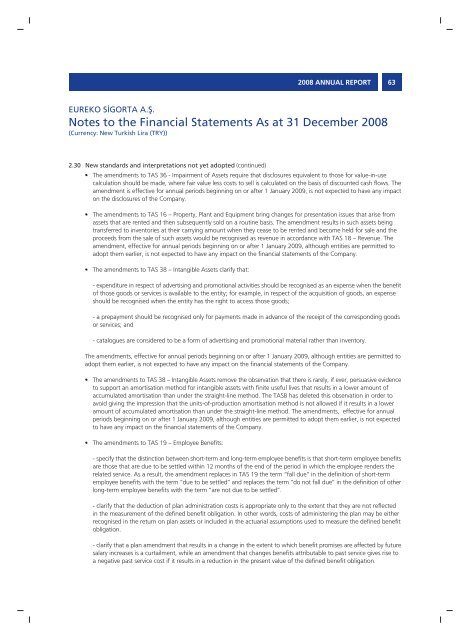General information - Eureko Sigorta
General information - Eureko Sigorta
General information - Eureko Sigorta
Create successful ePaper yourself
Turn your PDF publications into a flip-book with our unique Google optimized e-Paper software.
EUREKO S‹GORTA A.fi.<br />
Notes to the Financial Statements As at 31 December 2008<br />
(Currency: New Turkish Lira (TRY))<br />
2.30 New standards and interpretations not yet adopted (continued)<br />
• The amendments to TAS 36 - Impairment of Assets require that disclosures equivalent to those for value-in-use<br />
calculation should be made, where fair value less costs to sell is calculated on the basis of discounted cash flows. The<br />
amendment is effective for annual periods beginning on or after 1 January 2009, is not expected to have any impact<br />
on the disclosures of the Company.<br />
• The amendments to TAS 16 – Property, Plant and Equipment bring changes for presentation issues that arise from<br />
assets that are rented and then subsequently sold on a routine basis. The amendment results in such assets being<br />
transferred to inventories at their carrying amount when they cease to be rented and become held for sale and the<br />
proceeds from the sale of such assets would be recognised as revenue in accordance with TAS 18 – Revenue. The<br />
amendment, effective for annual periods beginning on or after 1 January 2009, although entities are permitted to<br />
adopt them earlier, is not expected to have any impact on the financial statements of the Company.<br />
• The amendments to TAS 38 – Intangible Assets clarify that:<br />
- expenditure in respect of advertising and promotional activities should be recognised as an expense when the benefit<br />
of those goods or services is available to the entity; for example, in respect of the acquisition of goods, an expense<br />
should be recognised when the entity has the right to access those goods;<br />
- a prepayment should be recognised only for payments made in advance of the receipt of the corresponding goods<br />
or services; and<br />
- catalogues are considered to be a form of advertising and promotional material rather than inventory.<br />
The amendments, effective for annual periods beginning on or after 1 January 2009, although entities are permitted to<br />
adopt them earlier, is not expected to have any impact on the financial statements of the Company.<br />
• The amendments to TAS 38 – Intangible Assets remove the observation that there is rarely, if ever, persuasive evidence<br />
to support an amortisation method for intangible assets with finite useful lives that results in a lower amount of<br />
accumulated amortisation than under the straight-line method. The TASB has deleted this observation in order to<br />
avoid giving the impression that the units-of-production amortisation method is not allowed if it results in a lower<br />
amount of accumulated amortisation than under the straight-line method. The amendments, effective for annual<br />
periods beginning on or after 1 January 2009, although entities are permitted to adopt them earlier, is not expected<br />
to have any impact on the financial statements of the Company.<br />
• The amendments to TAS 19 – Employee Benefits:<br />
2008 ANNUAL REPORT<br />
- specify that the distinction between short-term and long-term employee benefits is that short-term employee benefits<br />
are those that are due to be settled within 12 months of the end of the period in which the employee renders the<br />
related service. As a result, the amendment replaces in TAS 19 the term “fall due” in the definition of short-term<br />
employee benefits with the term “due to be settled” and replaces the term “do not fall due” in the definition of other<br />
long-term employee benefits with the term “are not due to be settled”.<br />
- clarify that the deduction of plan administration costs is appropriate only to the extent that they are not reflected<br />
in the measurement of the defined benefit obligation. In other words, costs of administering the plan may be either<br />
recognised in the return on plan assets or included in the actuarial assumptions used to measure the defined benefit<br />
obligation.<br />
- clarify that a plan amendment that results in a change in the extent to which benefit promises are affected by future<br />
salary increases is a curtailment, while an amendment that changes benefits attributable to past service gives rise to<br />
a negative past service cost if it results in a reduction in the present value of the defined benefit obligation.<br />
63


